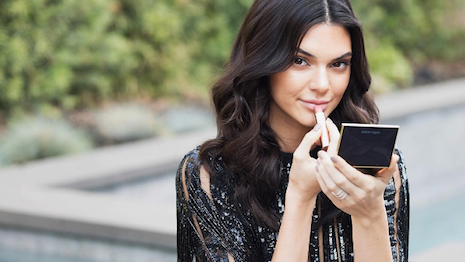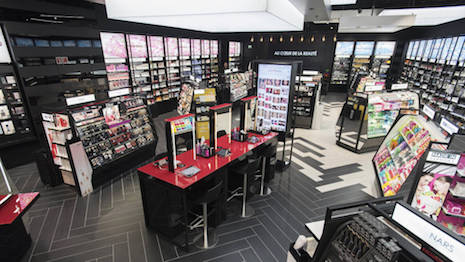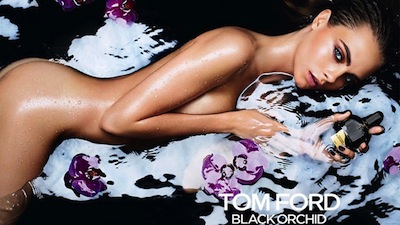Social media is catalyzing growth in the $237 billion beauty sector by fueling consumers’ interest in their appearance and their desire for self-expression, according to a report from Fashionbi.
Makeup, which saw a record growth of 8.4 percent in 2016, has been the main source of the cosmetic industry’s rise over the last five years. Fashionbi’s “The Art of Selling Beauty” notes that aside from makeup, digital is driving the sector’s acceleration, as more beauty products are purchased online.
“Nowadays a lot of opportunities can be found in the online business,” Yana Bushmeleva, chief operating officer at Fashionbi, Milan. “For example, L'Oreal Group ecommerce sales grew by 33 percent and are now equivalent to the group’s fourth largest country. More than 30 percent of the company advertising is now digital.
“One of the challenges…for the existing brand is a competition from the new labels that are created by the beauty bloggers and celebrities,” she said. “If before these ladies were the ambassadors for the beauty brands, now they create their own products, for example Gisou hair products by Negin Mirsalehi or kkw beauty by Kim Kardashian. These types of brands are also advertised and sold online.”
Beauty business
The beauty industry has been consistently growing over the past 10 years. While post-recession 2009 saw only a 1 percent increase in sales, the market has since been climbing at around 4 percent.
Cosmetics are dominated by the Asia-Pacific region, which accounts for 36.8 percent of sales. North America follows with 24.8 percent of the market, with Western Europe coming in third.
While makeup is behind much of beauty’s growth, lipsticks in particular are proving more popular, with a 13.6 percent growth in 2016.
 Kendall Jenner for Estée Lauder. Image credit: Estée Lauder
Kendall Jenner for Estée Lauder. Image credit: Estée Lauder
L’Oreal is the most dominant player in beauty, with $28 billion in sales in 2016. The beauty group’s Luxe division is behind the licenses beauty labels of YSL, Giorgio Armani and Ralph Lauren, while also including cosmetics label Lancôme.
Also making the top five is Estée Lauder Companies, which includes the flagship Estée Lauder brand along with Crème de la Mer and niche perfumers Le Labo and By Kilian. Estée Lauder, which has sales of $11 billion last year, is also behind the fragrance and beauty lines for brands such as Michael Kors, DKNY, Ermenegildo Zegna and Tom Ford.
Shiseido, in fifth place, saw sales of $7 billion in 2016. The company includes labels such as Clé de Peau, Laura Mercier and Shiseido as well as licenses for Dolce & Gabbana, Elie Saab and Alaïa.
Online sales of cosmetics grew 20.7 percent between 2015 and 2016. Brands and beauty retailers are taking note, incorporating interactive features into stores and digital channels.

Sephora's new connected stores in Paris. Image credit: Sephora
For instance, LVMH-owned beauty retailer Sephora is introducing a host of new features to its online store focused on personalizing the purchasing process for individual customers.
Some of the new features include individual recommendations based on previous purchases and a personalized welcome when past users visit the online store again. Sephora is banking on the growing trend toward smarter online shopping experiences to help drive up ecommerce sales (see story).
Also, Estée Lauder is helping consumers visualize its cosmetics on their own faces through a personalized try-on experience.
Buying beauty online without a trial can be a challenging prospect, as consumers are unsure how a particular shade will appear on their unique skin tone. Estée Lauder is looking to solve this problem and drive more confident purchases by incorporating ModiFace’s automatic facial analysis technology into its ecommerce platform, allowing shoppers to view makeup on their faces in real-time (see story).
"New point-of-sale concepts and an aggressive digital strategy can help the brand to beat the competition," Ms. Bushmeleva said.
Makeup marketing
When it comes to selling luxury beauty products, labels focus on building up their brand image. This is accomplished through the use of celebrity to evoke prestige or by sticking to a particular personality or story.
For instance, YSL Beauty maintains a slightly rebellious tone in its beauty efforts, while Tom Ford leans on sex appeal.

Tom Ford fragrance ad featuring Cara Delevingne. Image credit: Tom Ford
Luxury brands also fulfill a role as trend setters in beauty. Because of this, they often are the first to break the rules, such as Chanel’s casting of Brad Pitt in a campaign for its women’s fragrance Chanel N°5 (see story).
While beauty brands occasionally gender bend, such as Shiseido’s viral “High School Girl?” commercial, which challenged perceptions of sex by making up a room full of teenage boys in drag, marketers are often finding themselves needing to reach both men and women with different targeted products.
For instance, Chanel does not sell men’s fashions, but it does market men’s fragrances.
Additionally, brands that sell both fashion and beauty may have followers who are only interested in cosmetics.
Here is where diversified social media can benefit brands. For instance, Dior expanded on its centralized Instagram account with a beauty-specific profile and a Dior Homme page, allowing it to more effectively target consumers with particular content.
If brands do not want to invest in running a separate account, another option is dedicated hashtags, allowing followers to track a conversation, for instance #DGWomenLoveMakeup.
“The beauty brands still rely upon the celebrity image, it is still true for mass market and the premium labels,” Ms. Bushmeleva said. “But a novelty is that the beauty advertising campaigns start to be more inclusive in terms of the testimonial choices.
“Recently we saw many examples when male bloggers started to advertise makeup brands,” she said. “Premium and luxury brands prefer less risky scenario and promote the female products via female celebrities and male products with male celebrities. The celebrity endorsing still creates a lot of buzz around the newly launched products.”
{"ct":"QkNg5ixKuPt48KEwuMBkH1rb0Li0jtYoWvAK9oGPDJpWBM8q7962q3rD7rBJvYCS3EJyEUB2qcS+d0LFo5yGpjsNNAvPI8hDBgxvHpl504y6ar\/TwqMqc7wAAwB\/mV3KnBFAdnR4VhWlzvBEtacmZ+TsT0oKsMbW55O62F6e9A1k2Lt9uugQ6164sUhXbQ02F3sDmwNeQFXz8wzyAQ+3nr6A5jwhwnrjErqCcR5dL1caRhOON78CoARYEiNIOm1ZjpxKWvBxeCfE\/u+zYS+jy2pWRGWzK7PLW1TDOOkiB6etv\/SQPy9IDMAsusdx1ZDEVEEyTu4GkurY88lgCFin0wCubs527sbtaHCBbZnu8aGJ6R+0W0cHHBS5lllbaBwaTYHSIBpzThcYwVnylxparF8Hl09PzIcVB74+Q3SEBSvbz3kfLDaCLKWqUHKObyl84THpbmMUK+F\/kkub\/XLw9oUWyIRmiBskRQcD+P2325l968uA+uIVt21BkG5K7boaiZgkLy1+6YqTcc9ZFL4ZnQsbyo8sgic04VYOPKExCyckNv6uUbfVkWhGXjuXOPeg8uaO+KL3j2QheHZrwBWUHVsTraGqmA+0OY9IdbZIdjDmj2776XptBH76PXX\/hcrrK7KoQ4PGzWF0cse0HZGSZhaagvaMiZgEQw+jT9GSC1qezOgfhd+me3BD+cqVm8GEvibe+2d\/oGIBpTnoPPhxRv\/ZuJag\/orT8VmrM7aKupOhMIK3fjkuOxYVu0Wtgh1OqRzln9AFL3yBPbX8ZtirRowh0TrciGSlNo4BF9PbQGHHKBAPUah16Z2BFPneRIQB4kynmHfXso67Xid27fPbM9Niieu5pIL12pVkAsfAX\/7VAaRthodCTYkLzPuA6xa1I83dvgqdpA9Nxv1ILNsN8g4m8cWzj8IJVXGh+hmbxkJtkUvZNxLAGWn86DTRoxgkoWNhwGugwbkFhYLXT\/QeEuuyA5ImWPN2R5NKNmmWaKFeUS1yurpiqKosyO433bABGvrryP5gMfCTfyHWQs513oVa2a15sVK18\/Ap7gO2cdSGU6Fw1m4SkDyEWwjvioPgPuOwEM5to7Jvtvg94MWDE+iT0RypxS5NlgklhH38jZA5409lv7epPta2JhUXl39+i8FMV8EjjHyO1w5pas2bq6AWCnFD0oRvQkS\/LCycGLmgO95Wy\/pdYi57cWzdTLMScpLlTLvJsNKbn1zPOf+8N2a+v0ULgk+q6mwY4IKcjB7\/F1MLpWALlK8z92nxJJ4EZyNFuteigwIV84lUpQhckenac7TXgYs3ERi1nQKyCEhuMgbjfKdNXZhfAtxYP3lTVrckg2PS8BE1DaLm4rXXYJUToitLUVREipilBfEkN7ZdwNKYbm0urAnM5HhxjUNiocotBEfyl1UNmdOH8rAayf8K4yWVAcGCDeEcx8Nc4kiamEl5Jxo24\/hX0v0apRb0nTqjOVXFvF6kOVOshhIg9UoMsVXO483fVMHbTRTrimOYRyhdsbGo5jc3nFZrPMd4kobMmtFaRjuhfEKeREbsjtj94DfDoIGPcxbLq5rH5U3VDNGNNMlE4Msq5nIEaw\/IvwwoFTF18RiMlHa0jXfxm8TBhu5XkB+76ef6GT8Xi+z9jpH+mqtMhU2O9u4FTDv+f7ZAswCiG5SDuNWEKnWBL4+h8MnrXsvfQVWpEiAzEw+LLI+4Ll51KMszM+mCW2B5IJs\/OUwUmMDK3vGQ04j75ldnzhxMK7eWwF2t1iYqD2FWeKsNNQhqIsdr+JrUFMDh0rXGE3435QbERjEVUaI1BpdiEfCMt7+WI+KQva1fpxZeraUtyOS7BfHdA\/Fg\/0WIOeKFYg\/XNp0Q5uuhx2CK6xR94XwZr2CjfDaQy4xS96CpUKqlm\/66CO0acZ2nMwruNc1J1SpJAmUAFvTMPARw2T9vEYw6UR97YkpWoMWaJuLsgYLnNWby3HmhAWfxqHkDgyuf7ICzVYoyPXtSTCFz7xvYomF9yh2y0pu47YVJEtn9ph7e9WDNS3NJiND2RLlMWpdsm7kMvB5t3yRZLXrsJdb7utXjiLLYIMaVO6Q23z8LWB1ivsPt9ci7lIug3XKt9eeIqwKrX3lf5VJ2+fzt3RS6FjNEadnzQ7IqWC4QecRZPvX4rk85d9hRlY\/uMoJblEMbbJqt++EC\/3ZjjqU3l9yLCZ0hSv2kZ\/xsxpk+1PkszwR9Xf0le4iDE25whjf9eL\/pz7Wl9N+TnvP5BTND4+qi7v45XK1d9BPvuL9JQyWBXiGne82HxZquXDqHJoTwE9KxNdQmbtdbWk8Ny4CmI3wcfHBgQqCa5n5ry0xFFacIqKpird39Xz28xSpmjSkK2ALa8w9p5yvQx8hOPYmxUd1mhaKDTcqStxed87sti1LUDAeHlBUKRfQcadzr2HZ0O2Vq6tDvEk7+gnBS\/+VTR+eVKwWWfFIiyThpBPIT8mZnMUDb5Wx8PoaPmJjvlY3N2JvYe8\/LhkNe5pFsf7LLdyHIniDot4NkU\/\/cqRx0TgC4SRi24BKZG65MnyECwARaeWQR07HgHpyuXYFSjL2pJ32KLEpG+mCdVY335KlL0NjbwjoYKBtBMaOGTYMt5h3fxhab0PsYhvRWWOt\/WoYPTUp8LGtaJU7DVzIyW2QjwPRVaUK4ACGV1mEVpowcLf3\/vrL9ac6RwnxRlag5mi9GynZ4mxyGfI7KnoHpinDR\/yaUy8mpaYmP6xZy6S4ZMXpXJSnYQFeKWjGmZOvmXmodQdlm8kCmLccSnKRGwcviLlf9YLZ1jCUJr45Hsb7un9ujV3dTpp6LKk2bk8DysGRkXZVu2FD+dYec+\/X53nvKqc34Ufk2l8NoBV1hB5TYszGFkYr8NVaT8M7EspqMvgT2rdZ2gJ5Aed3RO6zF5F6zc+4AvhNh3QeTmBeDHfSsSUw7muSJADMbiM4VYwfQDrcak9CShMnhqUDKtuAMUclFnmxyAS1ZGiUCi48\/91\/+2PAa0t9mj2FPLPIxZ6ToD6StonGB43FnGxI4zDJ\/BzG3C7XjjFeSa01ublYj6xabdVerLnkHgx5Pqz1roX0b9WubkpOmfSdZWTbBSa8erjwdjUXI\/pVtIlao1BsDJlfFCXOiFyH7WvenbcW4Ng+leyXsO5yZRDPB4w1tb7NNPTh4pyEGH9LIRpOkESB5L0L65Paw34s6ZlCCVv4c6R2\/KjyDm5DvGEV7yKVsQVIW+oGwffPLciy3n3sK3heWr1m6UFozq6s0iA3k71vDGciR9glU0P06fBh3fT25krNli4ylMlVFfEet0Mx7oPCwDiYNQthrTI8gPof6soPpjvXfCSMoRGWZuJU\/i9Cqz8WXEyy7NcZVP74kjva\/uHCsjVRl\/bPI1zshzgWngePMpXzG\/x9dCNA61StJXjpsHVFqj8P\/Uymt7CCxCgyBCzb63O1ffRPprkUXbHVJcWmImRAhsCYspp+hj+\/\/csJzWfHUQtUvtm6K4dpdc6hTHQGxM\/0fYXyvYAU8SAyL21LBECfq8pZ\/dm4N62O8JxP3kQW\/RONQwTqjbV0kW\/Y1qeHudleCVSh7CkRZX8lypOPLmGlK+d9JhsX04dSmvuILGNqyoMse8SEgF533Q8s9YN6TG82cyJJ3yQquNhKFAUn3WXeZtFJropcHZALlIO\/07lS9+s\/zWA71bb\/0HNKzbieh\/WgAR4cpe7lhSaAZxECGanOTnjM2NHTUS31B6iJYMMSPe\/wqgeAURbEjKiyfKYe7rRrfVm6uBiVOuIIbs8YEL8a2585hrZaVz3vy9GEuSqs871FVmlLABEFd3gVX+fER6vSbw7GXAzsUYg8TZmIc7Ig6fd1XtFawvJj799amVutTfnQ+DV6MvPG5j0vVG14h73dUj2OeakGdvXbob4ragluEoBh66D1QRcTiU5rbZHQLwk\/aV\/9+6nTjvVyukJs2VbZBbPJPsuA6JkOT3ysAcIBLgSxNK4NSEIHtN2aWoBYmhYJ9p16+9vgu5gwdEa6\/r61jlwXCG7pFCHcK+m4fm2qNpVtCJjtUDZVXM7MQ0L\/po0e\/GvcolqtZNxgmLChhZUqX3aM1RkZ5hCqgVboIml6nFDv3dpkKLD9qqBWKi5W862wd6Mgp+lIWhXofQR98IOmjI+3NCKQfLkJ0O41Kd3umCGRNPI+45dYKt+iAYGWBR9ST3fkAgt5IbT7eKaV1bcQCRgoOocb1T4+sp7b40141Ay5LKZSwq\/gUvxFHkSa5++jbZoNG\/I0VzB85j5493UH8RlXfjhrJU7oYH8hhTejxx0ud8iaJ1hH\/xMvX2TwIzA5orsNfFSQOdSHIyUa6vu\/59J8dudvODHuqr7IcdKVPUWJsEBV5OeUn2Ggq8os8vCfT\/D5BgGOhoiJRp00OtlIFUdys2GVm9cWt3iXrlAFN7ZWgYHpFgXKEjptfWZbf6AAPoZopKZhXchHCqVXt4mds0ZA\/3HVhsi39duW3Cbxy79nkuzA0MqkZ0UA8uS\/NvUUrN0JErQ3o+hmuYZyhgXM7AUzuYFiZU07WQ+q8jk04gX7MM+okjJoCi0cZwCbHbu5vDzKc1AsPw2EjPJa24yEYKWN7CaW1Ju4BQTXfkMrl1OFz9fxI69ln3H9ReXJs79+EVZgbz\/rI6Mkbe6Vp2y3BDS7\/qsQ3Hpg5tmFpwZevJauaCAht4MXAkySAjYgZpvHP6q0E8hI1snscxf0LPt5hWg5FrPq3qbHvC2oNvwOuoYPi0KbmvE8nOC7NelMtZYOqCcX0nP+48fGH+yQ2b2n9Gw7f2BHeFB+4+8cY+cdlBCOIt2t1LBOL+GtcxglPkv5Vb\/fXjFT1WsFS2eSFtXeF9aQ0beJVosvsENmVe2jUvEMRZ27viiDaLJu4lU5Ldc2R2N2ozP7mZKmoy2rbrL9hzkghu0yw4zlZOpHZdVWXJ4x1HH907Zx1Y\/0BSysXQkEG\/xOyVdnbgYzhjGV82cmDN3pccNk8qUjmd03TBW01J2Ub3jKQf8BatzyHTNofT9WOHT75IX07aX0+fGCNiAmyTCANeWW9fDu5xMCBDIV3HgK70AQybidL45GxD5oLsHnvmDlUDurykB20bc7IaJzHLASx5gGxaZSqEAYI5wMiLUvWIc3WdZOzSAzh87ssEj79VlmivaxXK\/uAq+a3vhGL+Daz2TAfbzJh4eAhAuunTLCsrqkEFie4AoTqbRtCkaSLm4PXC1pXUJ22u6UxRmGbgL2sjIMDguacl5Xs+gv7ZVIzxzOpiZOuakgQt3KXodS2MRDiccqCQ6tftCJlrp2JEsmKbSQEKXrwK+WFqKWnqm8X0L3U0OsJ0UiXej\/FMg8VU1DMxN5Vi7i7QHEQYOs3yIrP3NSL1Zy\/LTeS3ToaXMDIfH8sMpvhOv6MXLY7fVFFjxKc5UIFtXYDbxoVwi5upgq11fDMkqW1xrNPlt+Pr2deoWTi3viIyI3ACFh4hodL9N83dEaZ5wtEgjONEC2TQbflRB48JHAddN5AqatfpvUoU\/XNijciYFccyADZCbIvMxgRKiYJ1AcO3lkWxO\/Y+CMkJCBUqVoswIi1MfK85sbNz0A9YJj0aVxGDTagDE3umke0eKuEO4\/DEeubrubyikzhaqDAFyUDDs8zg7bKQ6s+z9pt+EPrhcnapM9z5xxw\/2f7JJby0TX0BLDDsafwGPUnCNCRepTBSfddc0kKX2E254ciWpx7mAhRfbL2kP9nEZTxBWjSanITExLPA4huWZx1v17wUEpYnYjTIV+eXtBg2eYf7PdNKlxA7EWqsDOyGHYXPaYB0swQe8ibmA3jqiFNJakNEOAYDfTdrQRcPPWZejJ216zY9oP8+zPKD9rgAJOKlLm\/6OM\/+61JgfOUOvdKmS43sbFS1CHfMbtGJBRFzPoQ2y13O\/hC\/CUAEaYBtTnVhOpiCgAZm49R03hGMkvNTh\/n4fKe3Y6dFFVj\/E98sUZf6sXsWWvPMIvDgDq8+0D2ZG+Gm1uC7M96UW6OqURbqvGDu7flwXfwJgxb9JUgfBg8mLsnWjM736NPMKLWs37LyV9mBGbS5usWFNqpNnAjGrxOmhgtEd\/1HYlS0RChM\/lfz+wDGpVE4laZ+Hb8WGodHV77Ra8RHcZ4YPHmeHIqm2JeSuchQqOOHBg8OA4LXo5FXkB3n738J7fYBIPxyb8E4QsHMNtWNDVGa6FtbKvPMPJMKYMaE2iqPK+eyjUVLOdiCxx7pI+6xYOIPKRmzQWudmQRv9nHXOBGftlUJYqqhdJvW9zGWEc9nv91BvXmhkAynkvw18UDTFEQlsCxY40pMJfzLFJfevMt31UJuBLuBRD5yYbPytv1zzJX5a+A7MMY5fAHjswT4RpG\/rh+dyHulqxVVBX\/H8EJp8dVXAy5AK2JZYYjiPBNhVG3I1Gm86g8n7nVSO307Z+WoHeelx+e2rDGj5oo6MHQh6UPHcOpBslSt00P55pJrpHW4E0ef20YTyluuURGdeyu\/btEu3G5bdw2IHae+xb7KMfeMmtn7qHtmYa3fVA9m0FTPGYpQuWElQ7X2tYCWMqY\/PsIBXixo4yN9fFfo5gf8r1nLs6lFksisQ0ySJNBtfE5TNj3Lconh9jgP+hBzlsPYKqnu6FAH4acRr\/qC6PlZs9YuLM\/eeKxCzMlSghFWHMbzz5w+w5LG+g6SDB2dKvUKamfH8v8vSSSAuyTOlLPuP1UZuL8f9V6Fw1GustbEwGvkAVV8VQQoqTmJaxq2AYi0MGNpUdy64Wih8\/D9KwNMk0oNvUf4j9MMAu24KAVR+aBqmKqfjeoOUaoT53f4FRHK1R+t87pT6tLLdU7Zx6fJwWqlQBjpFBv7xEIk6CTgs\/oqxq8VX4CkhQLwiu1hiXUjlyhAxMZj4oFR1puhWeKcrVbDzpxoqHBH7t\/9u3VBlvHc+Qy7PCc\/0vijJ2WG4vIfc4wt8GFuTTDHVcL7vLixD98nZrKlnjqfS66anSYqEBU7jj8miISzUvnWB1GzX\/c1O8K6HVm6FzhKKxKUdUblEKaEcbebZ4jKhRfXwSJclWHNrhthKKIo\/G0YG7cOyDhMArkRy8oqjhFJ7kny4Kyh4+aH4aHVwVKrbdBV9ZUWL3+4FKNlrsMOlOU5oJtISqotjrjz6s8E+eeWHftyzX0wVYtvy+rRjkLldZBHNacgfe4KEHZVoHSxscjq1rz2+bmNbviNM23SYRU0Pg2TTexRbf2zWRuoifaGE\/fYkhDZ8XfbSyfLPsFKunWnh9HUw1UDvWgDD727K2PkV9sw\/xnCqqI6ok5k3IuxOh3tERl7UodBaLO16WMQoeyZednEiiGMlsEzy2cRClB9wyf03LZhZ3yIt9nIbUVFNRLfgyNAo8\/IJhIrnHGWkvboXjl8PCXPeNs30wxP+GpYvigze0ieer44s++iOqT8r8fj2Rq0KRs0NJn9oq0vPCEhvdDh8i3bhEN1ZTzN\/iNOFeCjfi6\/Ek5VFQopuiB0Vqh1XKZerMeikQM+WseCo0nnjlTyqEbBFFngxMQKYiyS26uFGCAkeoRXOwoFg04RvYAJLFtrGw8RUSSpOsRrfSwGIZ8PVgEwNqrIRV6JJId0acrsNtwAdEE3QHVYlcMdb\/GmGYaulsGUwaI3vZZCe083LFOEj16EnaEuCA+oAhWc2Q4j26ZIQJ\/Z5grofspfp\/8txaWcIgS7NyNHnFFouUrZEY+eMDaINvywdsIyEzFxiMunZCJzMpp3FVHTrXlXaELpvXeOWYDEBuqxBF9VXKsb84G9OPxNysNU6JmC+afFYJdAiD1ajyn62QDN9GuSpjEhS8qRvbgr2SVKiIobpBuDVpS\/YloayEpzR4kon8EZKfDgZHyUTdPKph98Zjf6ndkcStqKpiTm8Fhmeh5enlTJ68VTCqrXRy1ue\/U4BEFCTLNVMb8qxVI4K6CmCFcgBDEewnolegHjXg8Zmil2DC6zKYRS1fIAm8YjcpJuEvUI8wWJfvtSD539Pf\/UoaB\/B0tOiWaAWFG1MZ5I3HGgb7rDlHXtZBs5erMwd0Fl8kq6aNmF2RQUZliQSud7wcfCpJLJdujvlzcbel1Zuzp2dazmHLeHhM6kJc1c1QF7rA2xJxF8uFuy2iIpZ6Ug0QWUG8ETph\/lGDGOV13cHDYHqqmJaDTtCVv03fIGLov\/K9yx4GKT1b04Jdt4QE0iYVm4PfU9B8e0bUBLyWD+H4MwdkYdFzvIkzpUQQfYqoRlUJQ5dYqLAi1HEzARAT9fAvQ7hUQlscBhZc3azWNoN5bFe70EBDpSuQ5\/XTSdm9pINVQKR6Ue2DVv2x\/B4CtLJb+M7+lQuO4Uux0DtYOQm9WC47y8PG4sLNgKRireF+HkM9cFxsbdeIyz5fmzpB7BxDMF0zI1ckma7vMocWDwZBl9zmo+El\/vbasR7PYHcXb\/tH+0Ts7ygmxRS8b51+BtkbM9aH9veIBtkev\/dBmJ3UZhMiiQ\/XStzAhPAFZMFzg0g22jkny\/68iUzwrSNs+nLpAcSs0k+IWtms\/8kxnoX859r4VuWYaOaPyGUUPulACStxr7KHsDq7EGOHHfNmbzSRY+g4B16U+sfhbyIxn6Ou6ajteqXOojXBL73QZ0PHRUkzcTpczzS2AtnPJdRuRPKBJWy57VPzlZZi5lXbLav6cbX6n8JaGGcyQk6wD7QGWRUdjG3FDpHTS139gepvyPYgRQE\/3aC4qb5ZisYYtegnDJ+7XmXMWWQO2i0nNHYI14yUvbpUqWKIX\/W\/RXPKmKevpL9jf7bOkOP\/dFP4AgWLyAvOC\/EI0fzDe8YDf5LK4sc27mMH7xOH+qSNrVTUmmsVHRpsNaPSeDYCs1dGMfrUdf8Xy\/WJskDjNFbHuybiF4Ys\/pGUB+KvlpCSkrxrekVDfoXd+2cQZ+80JHp3ThpN2o0h926R6yDWACfSWhH09Fp1isDL9I+is9wLioKvZO4m77NtZozLdd4Y2TEOq2Iz9flGzgt8mxWZ68CvPGyILg2KNAndQAK3q3jaOc+DPrDDLRzgXTB5PT8ARxecBR0lFjQ6KgdNgmuQGv\/BqsmepVSEWJOWX9CubS+lBYYyL\/QB5IyubzszWZFQjsDfDo+4T\/pMXewIMz358iAlrmgr2e8pKyyLzhG\/iLZbCcE5ZApxapGF5OR9QEg2WmRsKRoGYqSh7BIg2tEFRi9hmmn95sL9DYzlTIDxC0FTPXFOcX6PaNQoD1ddT\/7xomfBERUFLIaxGfE0CH6GHk5sBTIOo0MBmNLlUG9u0gJrTA3iexDysTLF7Yw\/kqtIP8GnT0XJdbMlcZWj1+ERcTBignZALT+Piz\/vN4R4fkwRrrSKF741Q5s9eb6euSR31UgxjyB860zujmmSV6inWK1wCKF3BS2t5d70nFZ83LfPnn0HXNV8xOBXVl6rV\/4d5m2gzeC\/6Osvy9GU0gpyt3CPL7qlPtjJCw2qYDETWf8pD1p+X9V7NXtQeela2r0VoSM5g+MafHhhZqzQ5n5FSvDOYAziTDAqC\/S6uQaeogBpwgTS\/Xmo5fuoTKFH+hAiLQ116wn4L0RNkpJT9JiW20p4sflu7Im3PW+6C3ogG3Kt2fmysWFe6Yk50h70VfY7+RBhG5XhKFUqtQ2qe3Z038xuZpK5ONHLp6hYnc3L\/Z+S0ozqqtKtdt6yuunkl2B3bZ3jEYihKxu5CgLMyL\/RJCnqG56tF5Kl4wrsXbM9UlRyKn1qXA5cECTkLBhHAE8svRjnYWYBkuK+i8VTfW2TS\/NYjp\/ZSlSAUVU1K3vz0rafqKfCBUeMwtDqVmzXCx4KWYpqcSgSyPmq8wYOXPOY9MmpS9Rt9dapXir6ZBXrr61KrZ7aImpq3ptld5vvruc8eCk0OEnSHq7sZTmR5eFr+mCjBHtxFJPSLox+FTmo5NB+nh8QAzq6jb2Gxu3DPNvz0oAXAagZ7eWMKm2QvaGNejKGaH4U4hDDXAEJArAfFQ1kXVY4f1lkbYbVDf\/oA\/qSjjYmfVGLYZh+hLIzMvjhul0Ei\/dVaPfP2A7uVM5154+d\/GKWp2uCdyPZoBOWO\/MmOPV94Va9Z9qkgQDfUjWbFNzEApDmChYb53Wk0Phzse7s0Msnz3fJsRBMO7tEWsVXZK3uMI389Ovw864y6zvxbhIzhEMBXoKVoTefBiolSAosjp\/Os\/PLgiCyq3DNOzmNetVOM4GP7jc9J\/MFPMZ8bGtPOwH7W9DKVzZDpBrSRF853YtVtC5pdm0NhaqAAmnAfiqDp3ThjyqOqMckQ7gaJx0jlppDhSwN1kSoGxO4ajiDupGB5p0WC2Rv\/uDIWsfhoJwgNs3l1qsM\/KDueYh2NG5uzgHz8BjLi2ps86Iesf8rw6qfg5KYiqLbXg3ITmk0MflCbEZLsAFiTERj2rECeA54HoMTm+LrRmyS5eU8TlWASLxtlaXmIWHI63yNjRRn312Hai8sMm2E5xcKgIb0s3yyU2ipfai1VwHDcuh3Haa\/S8ZBDMzsihIKACncb\/efpRGwXjhqtBvN8GLJutiEEF82oYfgdtyhqJIfkCKBF9GX5S\/YyBw6+Unf4qrG2mo2+KYpHIJhHG2tUNu+8t9XLE0PT1+gNDA83zFwpH4aUY+xT8sjXrqpsWr2RqXEgGoD3QRYbEDsLxnt1inyi2FwwaorPK8BcpVu2+Z9xS+GRLb6eHuwDcelbOFnA50jxxSY34+zuiSUS4ns7OjQTBqPvLxUAIKH\/hDxsMlHI+TkkBiLziGrgi6dt+OrgEPF99qW9vNysbaf9Kyj4xbzbGM5nxrTFuSCJsbi\/JOgANkSZ2Y5kMRyVgaSSJulNTv8Kj7935awt6Ly5b26ClffyM\/UpFuDW3zRmvTGPCuJnOhs7l2sbDytI9v3VCGuPFTqN7lsJWc5quq0YjnfpymIRC9muPsohyJnTp+FDaImxmdYVsaxvSG56RuVatFrBkJa9Ekz8XKyWhKdV4RftezB6A5eoAelqlVB7EzEbc\/H9oK4bDCBNyn\/mH7nKSNwEgDRud8RHyMt0u\/wFWWTpYnChfJS+VNRsbSTTBSX8VnoJtRpZuzL7WtjhJLI0uVumXullBsriqmjCA57ACQ2e4pRrRrsOxr0ATWQqz4p\/4RosJjPbCDvyqfPt6mfEIrtew4QvFJrizT8w08m5xajgQJIrh8O3IGj2Zgvg533\/w7XwV1CCuhsKQ1B1pOBlYeI1p4m\/9dWA0tOFTI2s+qRYBaaXNs7fnmBKrsZY9wzjBE6qa6nOfeeD6FDR+SStcAsO7s\/PmzdieHCm\/3c6hj7W86uj1X8oOnYHx\/v9Yppxn\/zKg7w7LYk1GAacHS9KyAmweQGnbm8cQgVINVabp4z7yF3g8y59HrfU5nGd4ont9niE6uIbAcbRG+81","iv":"979538f2ed0bae4a9bca1f6cfa4f45f0","s":"e3080fff9acca1de"}

 Selfie culture is driving beauty growth. Image credit: Shiseido Group
Selfie culture is driving beauty growth. Image credit: Shiseido Group
 Kendall Jenner for Estée Lauder. Image credit: Estée Lauder
Kendall Jenner for Estée Lauder. Image credit: Estée Lauder